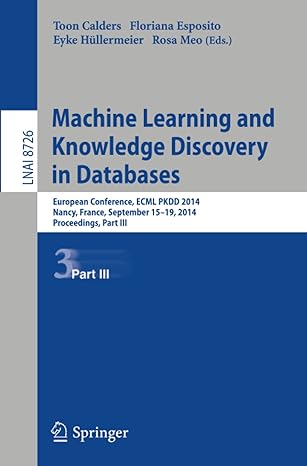Question
Given the following code of a monitor that is designed to solve the readers/writers problem in FCFS order while maintaining exclusive write and concurrent read:
Given the following code of a monitor that is designed to solve the readers/writers problem in FCFS order while maintaining exclusive write and concurrent read:
RW : monitor;
begin
readercount : integer;
busy : boolean;
FCFS_Q, write_Q : condition;
procedure startread;
begin
if busy OR FCFS_Q.queue OR write_Q.queue then FCFS_Q.wait;
readercount := readercount + 1;
FCFS_Q.signal;
end startread;
procedure endread;
begin
readercount := readercount -1;
if readercount = 0 then
if write_Q.queue then write_Q.signal
else FCFS_Q.signal;
end endread;
procedure startwrite;
begin
if busy OR readercount 0 OR FCFS_Q.queue then FCFS_Q.wait;
if readercount 0 then write_Q.wait;
busy := true;
end startwrite;
procedure endwrite;
begin
busy := false;
if FCFS_Q.queue then FCFS_Q.signal;
end endwrite;
begin /* Main program of the monitor, used for initialization */
readercount := 0;
busy := false;
end;
end RW;
Suppose the above monitor is used to control the access to a shared file among a number of readers and writers. Assume that the sequence of arrivals of processes that require access to the shared resource be: R1, W1, R2, R3, W2. Here R1, R2, R3, W1, and W2 are processes that are in existence concurrently. For simplicity, assume further the following:
These arrivals are 1 second apart.
Each of the monitor procedure takes 1 second to execute (not counting the time in queue). For simplicity, you may assume 1 second even when only part of the procedure gets executed.
Each operation, read or write, takes 5 seconds.
All processes that require access to the shared file will follow the 3-step procedure:
Reader: call RW.startread; read; call RW.endread.
Write: call RW.startwrite; write; call RW.endwrite.
Note: The time durations provided above are to enable you to determine the approximate timing of events. Leave an entry in the table below blank when there is no change.
| Time in | Process | Procedure | Variables | Condition variable queues | Process removed | |||||||||||||||||||||||||||||||||||||||||||||||||||||||||||||||||||||||||||||||||||||||||||||||||||||||||||||||||||||||||||||||||||||||||||||||||||||||||||||||||||||||||||||||||||||||||||||||||||||||||||||||||||||||||||||||||||||||||
| Second | executed | readercount | busy | FCFS_Q | write_Q | from any queue | ||||||||||||||||||||||||||||||||||||||||||||||||||||||||||||||||||||||||||||||||||||||||||||||||||||||||||||||||||||||||||||||||||||||||||||||||||||||||||||||||||||||||||||||||||||||||||||||||||||||||||||||||||||||||||||||||||||||||
| Initially | None | None | 0 | false | empty | empty | None | |||||||||||||||||||||||||||||||||||||||||||||||||||||||||||||||||||||||||||||||||||||||||||||||||||||||||||||||||||||||||||||||||||||||||||||||||||||||||||||||||||||||||||||||||||||||||||||||||||||||||||||||||||||||||||||||||||||||
| 0 | R1 | startread | 1 | |||||||||||||||||||||||||||||||||||||||||||||||||||||||||||||||||||||||||||||||||||||||||||||||||||||||||||||||||||||||||||||||||||||||||||||||||||||||||||||||||||||||||||||||||||||||||||||||||||||||||||||||||||||||||||||||||||||||||||
| Given the following code of a monitor that is designed to solve the readers/writers problem in FCFS order while maintaining exclusive write and concurrent read:
RW : monitor; begin readercount : integer; busy : boolean; FCFS_Q, write_Q : condition;
procedure startread; begin if busy OR FCFS_Q.queue OR write_Q.queue then FCFS_Q.wait; readercount := readercount + 1; FCFS_Q.signal; end startread;
procedure endread; begin readercount := readercount -1; if readercount = 0 then if write_Q.queue then write_Q.signal else FCFS_Q.signal; end endread;
procedure startwrite; begin if busy OR readercount 0 OR FCFS_Q.queue then FCFS_Q.wait; if readercount 0 then write_Q.wait; busy := true; end startwrite;
procedure endwrite; begin busy := false; if FCFS_Q.queue then FCFS_Q.signal; end endwrite;
begin /* Main program of the monitor, used for initialization */ readercount := 0; busy := false; end; end RW;
Suppose the above monitor is used to control the access to a shared file among a number of readers and writers. Assume that the sequence of arrivals of processes that require access to the shared resource be: R1, W1, R2, R3, W2. Here R1, R2, R3, W1, and W2 are processes that are in existence concurrently. For simplicity, assume further the following: These arrivals are 1 second apart. Each of the monitor procedure takes 1 second to execute (not counting the time in queue). For simplicity, you may assume 1 second even when only part of the procedure gets executed. Each operation, read or write, takes 5 seconds. All processes that require access to the shared file will follow the 3-step procedure: Reader: call RW.startread; read; call RW.endread. Write: call RW.startwrite; write; call RW.endwrite.
Note: The time durations provided above are to enable you to determine the approximate timing of events. Leave an entry in the table below blank when there is no change.
| ||||||||||||||||||||||||||||||||||||||||||||||||||||||||||||||||||||||||||||||||||||||||||||||||||||||||||||||||||||||||||||||||||||||||||||||||||||||||||||||||||||||||||||||||||||||||||||||||||||||||||||||||||||||||||||||||||||||||||||||
Step by Step Solution
There are 3 Steps involved in it
Step: 1

Get Instant Access to Expert-Tailored Solutions
See step-by-step solutions with expert insights and AI powered tools for academic success
Step: 2

Step: 3

Ace Your Homework with AI
Get the answers you need in no time with our AI-driven, step-by-step assistance
Get Started


